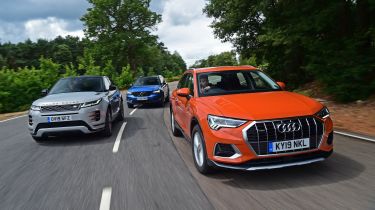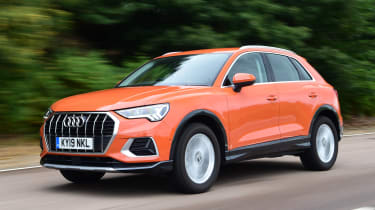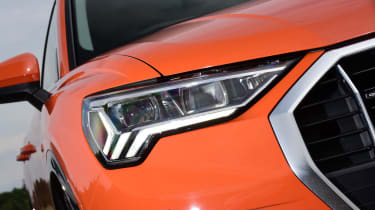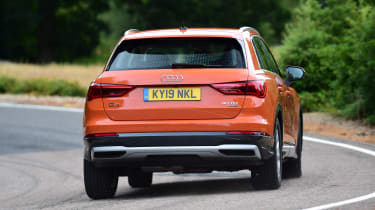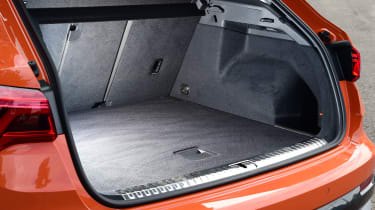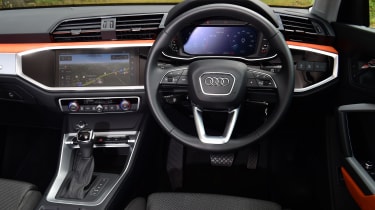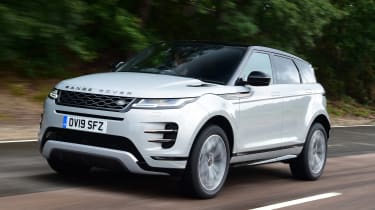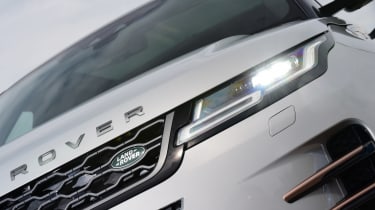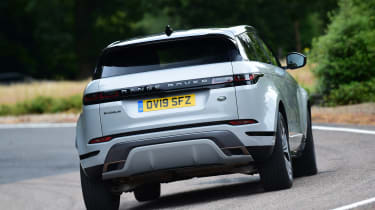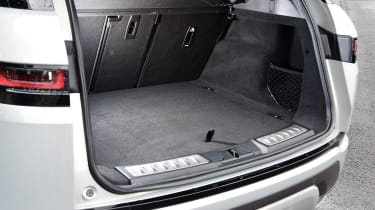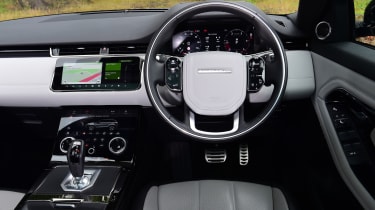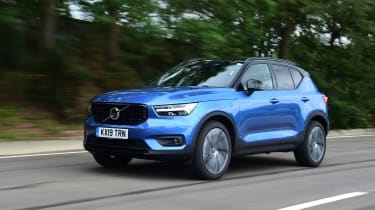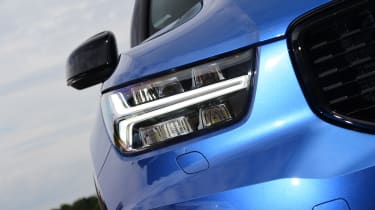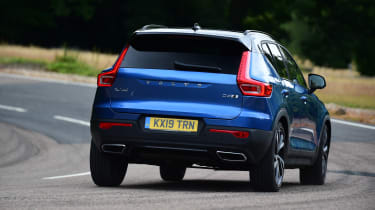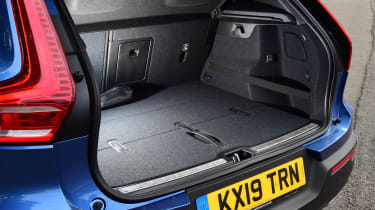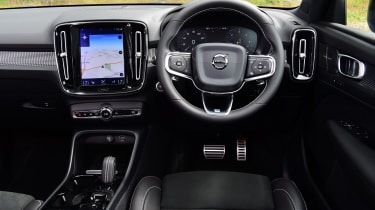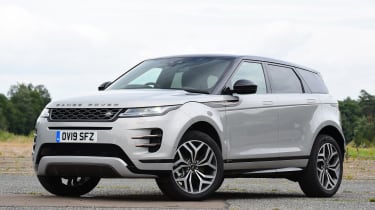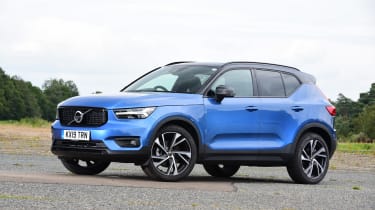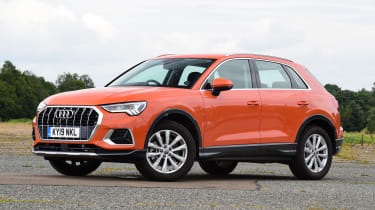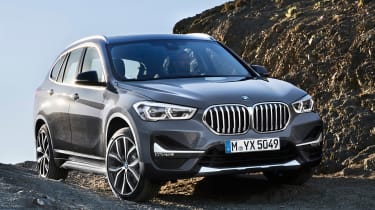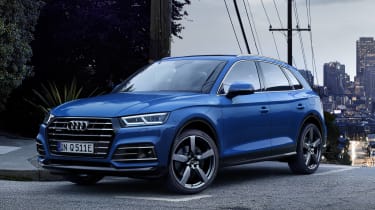Audi Q3 vs Range Rover Evoque vs Volvo XC40
The Audi Q3, Range Rover Evoque and Volvo XC40 do battle to see which is the small premium SUV champ
It seems like almost every week a new premium SUV arrives on the market. Look at the number on sale today and it’s no surprise that competition is close in this sector, with manufacturers releasing ever more of these hugely profitable models.
Audi was one company that cottoned on to the popularity of SUVs early on, and it has been offering a convincing car in the compact premium SUV class for years, in the shape of the Q3.
We tested the new, second-generation model at the beginning of the year in petrol form, but diesel engines are still huge sellers at this price point, so the 40 TDI takes centre stage in this test – and it’ll have to compete against our current favourite in the sector, the Range Rover Evoque. It’s more upmarket and practical than ever, but then so is the Q3.
Both arrived soon after the Volvo XC40 stole the title of best small premium SUV, and the D4 variant is here in this test as a benchmark to see how the Q3 fares against some hugely talented opposition.
We’re testing this trio in sportier trims, but which offers the best mix of abilities?
Audi Q3
| Model: | Audi Q3 40 TDI quattro S tronic S line |
| Price: | £38,115 |
| Engine: | 2.0-litre 4cyl, 187bhp |
| 0-60mph: | 8.0 seconds |
| Test economy: | 39.8mpg/8.8mpl |
| CO2: | 147g/km |
| Annual road tax: | £145 |
We’ve tested the Audi Q3 in petrol form (Issue 1,556), but now it’s the turn of the diesel to meet its toughest contenders. We put the popular 40 TDI quattro S line version with S tronic automatic gearbox through its paces here. It costs £38,115.
Used - available now
Design & engineering
The Q3 was one of the last small Audis to move to the brand’s MQB platform, but because the modular chassis has been updated over time, the Q3 is one of the most modern cars around – including its engine and safety tech.
Audi’s confusing naming strategy means the Q3 40 TDI is powered by a 2.0-litre four-cylinder turbodiesel that produces 187bhp and 400Nm of torque. Quattro four-wheel drive is standard with this engine, and so is the seven-speed dual-clutch automatic transmission, which Audi calls S tronic. As with its rivals, you get a multi-link axle taking care of suspension control at the rear, while the trio all feature strut-type suspension at the front.
There are driving modes in the Audi, and if you opt for the £750 adaptive dampers, these different settings change the suspension’s parameters, along with the steering, engine and gearbox calibration.
However, it’s likely that price, equipment and quality will be a bigger draw in this sector. S line trim gets sat-nav, Audi’s Virtual Cockpit display, half-leather upholstery, LED lights, climate control, Apple CarPlay and Android Auto, and loads of clever safety kit and driver aids, as well as the option to add more. You’ll have to spend extra on kit such as a rear camera and heated leather seats; the Evoque gets these as standard.
Cabin quality might also raise a few eyebrows in places when compared with the Range Rover’s interior. Some plastics don’t feel as premium as we might like, or as the price would suggest. It’s not as noticeable in the areas you don’t touch, but is obvious in the places that you will.
Driving
Downsized turbocharged petrols are great and can be quite efficient, but in larger cars such as the Q3, a 2.0-litre turbodiesel gives a decent level of flexibility, and therefore makes the Audi easy to drive.
• Best small SUVs and crossovers to buy 2019
That showed in our performance tests. Even though this isn’t the most important feature of a small SUV, the Q3’s 8.0-second 0-60mph time was the quickest of this trio, 0.2 seconds ahead of the Volvo. That’s thanks to standard-fit launch control as part of the S tronic gearbox, as well as sharp shifts. However, the trade-off is a little loss of low-speed driveability when manoeuvring compared with its conventional automatic rivals.
Despite its strong sprint off the line and full-throttle pace through the gears, the Q3 didn’t prove quite as flexible as its rivals in-gear – although it’s far from slow and serves up enough punch.
On 19-inch wheels the Q3 exhibits a problem that afflicts quite a few of the cars based on the VW Group’s MQB platform – it feels a bit too firm and its damping could be a bit more forgiving. The Audi fidgets and jostles when compared with its rivals here.
It’s certainly not uncomfortable, though, and on smoother surfaces the Audi settles down to a decent enough cruise. The slightly firmer ride does at least give the car precision on twistier routes. Its steering is light but accurate, thanks to the decent level of grip, although as with all of these cars, the higher ride height compared with a more conventional hatchback means there is noticeable roll.
Practicality
The growth in size for this second-generation Q3 means there’s much more space inside than before. The rear seats slide back and forth, so there’s between 530 and 675 litres of boot space, which is significantly more than its rivals here – neither the Evoque or XC40 breaks the 500-litre mark. Plus, the Q3 is the only car to get a powered tailgate as standard.
It’s also roomier inside, with more leg and headroom for passengers than the Range Rover or Volvo. However, that’s not to say that either rival feels cramped in comparison. So while the Q3 is the largest car in this test, there’s enough space in both competitors for it to not be an issue. Storage is reasonable, but the tray at the bottom of the Q3’s centre console isn’t the easiest to get at.
Ownership
These three marques trade on their premium image, but actually none performed that well in the eyes of owners, with Audi taking a middling 16th place in our Driver Power owner satisfaction survey.
However, the Q3 is much more impressive when it comes to the standard safety tech, because autonomous braking with pedestrian detection, lane-keep assist, blind-spot warning, LED lights and parking sensors are all standard. You can add the Driver Assistance Pack for £800, which brings adaptive cruise, traffic sign recognition and high- beam assist, although the Q3 scored a full five-star Euro NCAP safety rating without this extra kit anyway.
Running costs
Although the Q3 has the lowest list price, it also emits the most CO2, at 147g/km, so it sits in the 37 per cent Benefit in Kind tax bracket. This means the Audi will cost higher-rate earners £5,602 a year to run as a company car. It’s £308 cheaper than the Evoque – the Range Rover emits less, at 145g/km, but still sits in the top 37 per cent bracket, and is pricier so it’ll cost £5,910 in company car tax.
The Volvo is almost as cheap as the Audi and sits in the 34 per cent band, thanks to its 133g/km CO2 emissions, so it will only cost £5,120 a year.
Testers’ notes
“Standard sliding rear seats move back and forth by up to 150mm, so you can prioritise either boot space or legroom. There’s plenty of both in the mid position, but it’s a neat feature nevertheless.”
Range Rover Evoque
| Model: | Range Rover Evoque D180 R-Dynamic S |
| Price: | £40,515 |
| Engine: | 2.0-litre 4cyl, 178bhp |
| 0-60mph: | 9.5 seconds |
| Test economy: | 36.4mpg/8.0mpl |
| CO2: | 145g/km |
| Annual road tax: | £455 |
The second-generation Evoque is our small premium SUV champ, so it’s the one the Q3 has to beat. We’re testing the D180 in sporty R-Dynamic S trim (our pictures show an R-Dynamic HSE) to match the Audi – the Evoque costs from £40,515.
Design & engineering
The first-generation Evoque captured the imagination of a legion of buyers, shifting more than 800,000 examples. As a result, Land Rover hasn’t rocked the boat with the styling, by subtly evolving the shape to tauten up and modernise the smallest Range Rover’s looks.
However, under that sharper skin there’s a new platform. It’s called PTA, or Premium Transverse Architecture, which is an evolution of Land Rover’s D8 platform that’s been designed to accept mildand plug-in hybrid technology.
This 2.0-litre D180 unit boasts 178bhp and 430Nm of torque. That’s 9bhp less than the Audi but 30Nm more torque; the latter is often the more important figure for a diesel, and because the Evoque is also 121kg heavier than the Q3, it needs it to match the Audi.
The mild-hybrid powertrain with its 48v electric system does at least mean efficiency should be improved, since it allows engine-off coasting at up to 11mph, while it also provides up to 140Nm of torque to give a small boost during what Land Rover calls “transient acceleration”. Think pulling away and mid-speed, light acceleration. Power is sent to all four wheels through a nine-speed automatic gearbox, a development for this generation of Evoque.
Interior quality has also taken a noticeable step on. The cabin is the plushest of this trio, and the materials are good, befitting of the Range Rover name. While it’s £2,400 more than the Audi and £2,280 pricier than the Volvo, it easily feels more premium, which goes part of the way to justifying its price tag. This price gap is lessened when you factor in that some of the Evoque’s kit is optional on its rivals, plus Land Rover is focusing heavily on PCP finance.
The list of standard kit even in R-Dynamic S spec includes a 10-inch touchscreen with nav, while Apple CarPlay and Android Auto are both fitted as standard – a previous Land Rover weak point. You also get full leather, heated seats, good safety kit, parking sensors and a reversing camera, LED lights and climate and cruise control included. Unfortunately, items like a digital dash (£500) are extra.
Driving
Land Rover’s D180 diesel is even more refined than Audi’s 40 TDI, and despite the Evoque carrying greater mass, the motor’s extra torque is noticeable. It pulls well from low revs, with the mild-hybrid boost subtly helping out in the background. The nine-speed gearbox does a good job of making acceleration feel potent enough thanks to having more –and therefore shorter – ratios. In addition, it keeps a lid on engine revs, and changes up smoothly.
You can see the benefit of those shorter ratios and the extra torque, because the Evoque was quicker than the Volvo in all of our 50-70mph in-gear tests. In fact, the Range Rover took 7.5 seconds to complete this test in seventh, whereas the Volvo did it in the same time in sixth. The PTA platform means the Range Rover’s ride quality is very smooth. It doesn’t iron bumps out, but reacts to them with a relatively soft touch that the Q3 sometimes lacks. The XC40 sits between the two.
The Evoque’s weight does come into play though, and while it helps smooth out the ride, making the car feel relatively settled, this isn’t the most dynamic machine. The steering has a nice weight and there’s good grip. But then, as SUVs, these cars are more about luxury in an affordable package than handling, which is where the Range Rover shades its rivals.
Practicality
An increase in size for this second-generation Evoque isn’t as pronounced as with the Q3, and while that shows when it comes to rear-seat space – the Evoque is a little more cramped than the Audi, with slightly less head and legroom due to the low roofline and styling – the 472-litre boot is still a decent size.
That’s 12 litres more space than the Volvo offers, and enough room for four people’s bags. As it stands, you wouldn’t want to carry five people for any more than short trips, because the back seat isn’t the biggest.
There’s a twin cup-holder and storage area behind the gearlever, with a cover that acts as a tray for your phone. Behind this there’s a big, lidded bin and armrest. The glovebox and door bins are reasonable.
Ownership
A result of 20th in our 2019 owner satisfaction survey for Land Rover isn’t exactly great for a car wearing a Range Rover badge, while the brand isn’t exactly known for its reliability either. But let’s focus on safety, because the Evoque R-Dynamic S gets autonomous braking, lane keep assist and traffic sign recognition for a full five-star Euro NCAP rating.
Blind-spot warning is available as part of a £1,000 Drive Pack, which also adds adaptive cruise and high-speed emergency braking.
Running costs
The Range Rover badge holds plenty of weight on the used market, and our experts predict that the Evoque will hold on to the most money of our trio after three years or 36,000 miles. It’s predicted to retain 55.3 per cent, or £22,401, although the Audi comes close with a retained value of 52.4 per cent – or £19,976.
The Volvo trails these two and doesn’t break 50 per cent, retaining an expected 48.6 per cent of its value after three years, which equates to £18,575.
Testers' notes
“Most cars in this class are bought on PCP finance, and despite its higher list price the Evoque looks like good value. Land Rover is pushing this method of purchase heavily with the new car.”
Volvo XC40
| Model: | Volvo XC40 D4 AWD R-Design Pro |
| Price: | £38,235 |
| Engine: | 2.0-litre 4cyl, 187bhp |
| 0-60mph: | 8.2 seconds |
| Test economy: | 37.5mpg/8.2mpl |
| CO2: | 133g/km |
| Annual road tax: | £145 |
It was only introduced in 2018, but the Volvo XC40 is the oldest car in this test. We’ve made it a class winner in the past, and it’s a natural rival to the Q3, not least on price. We’re testing a D4 R-Design Pro model costing £38,235 to see how it fares.
Design & engineering
The XC40 is the first and so far only Volvo to be built on its CMA Compact Modular Architecture. Like Audi’s MQB and Land Rover’s PTA, this is a scalable platform that’s based around front-mounted transverse engines, with MacPherson strut front suspension and a multi-link set-up at the rear to accommodate four-wheel drive.
The D4 unit has 187bhp and 400Nm of torque, while the only option is an eight-speed automatic. However, we know the strength of this set-up, because the XC40 is one of our favourite compact SUVs and a former Auto Express award winner.
Inside, the digital dashboard and nine-inch tablet infotainment system still impress. Quality is good – although the materials in a few areas don’t match the Evoque’s – while the design is funky but functional. You get nearly as much kit as in the Audi, while the XC40 is cheaper than the Evoque, at £38,235.
The equipment list includes parking sensors, lane-keep assist and autonomous braking, climate and cruise control, half-leather heated seats, LED lights, nav and a digital dash. Unlike its rivals you have to pay £300 for the smartphone connectivity pack, adding Android Auto and Apple CarPlay, while a reversing camera is £375. Wireless charging is also £175; it’s £150 on the Audi and not available on the Evoque.
Driving
Even on our R-Design Pro’s 20-inch wheels, the XC40 rides really nicely. It’s sweeter than the fidgety Q3, and almost as smooth as the Evoque in almost as many situations. The Volvo has strengths in some areas where the Range Rover is weaker, and vice versa.
Over smaller, more constant bumps, the XC40 feels just a little more absorbent than the Evoque, but over harsher intrusions the tables are turned. Either way, both cars deliver a good ride.
The XC40’s D4 engine is a little rougher than the Evoque’s mild-hybrid unit, though, and is more akin to the Q3’s 40 TDI for refinement. No engine is particularly noisy or intrusive, but in the Volvo you get a little more percussion from under the bonnet at higher revs than in the Range Rover, while the Evoque revs out more smoothly, too. Performance was good though, because the XC40 all but matched the Q3 from 0-60mph, taking 8.2 seconds, which was 1.3 seconds faster than the Evoque.
However, as we’ve seen, the mid-speed flexibility afforded by a diesel SUV’s torque is often more important. Here the Volvo beat the Audi and was much closer to the Range Rover in our 50-70mph acceleration tests. However, with seven, eight and nine-speed gearboxes in the Q3, XC40 and Evoque respectively, there are gearing differences, which account for the slight variation in times. Realistically, all three offer enough performance.
This means it comes down to the way the cars drive. The Volvo is good, steering sweetly with adequate grip, but it feels like there’s more roll than in the Audi or Range Rover, and it’s a little less secure.
The Evoque feels more stable, with weightier steering and better body control, but it doesn’t sacrifice ride comfort as a result.
Practicality
A lofty roofline means rear passengers sit more upright in the XC40, which in turn frees up legroom. It’s better than in the Evoque, and on a similar level to the Q3. The Volvo is spacious up front, too, with plenty of storage and spaces that are more accessible than the Audi’s trays.
There’s 460 litres of boot space, which is 12 litres down on the Evoque and the smallest here. However, given its uniform shape, there’s still plenty of usability on offer. Only a long trip away fully loaded will really stretch it. Fold the seats down, and with 1,336 litres there’s actually more space than in the Evoque, at 1,156 litres. The Q3 trumps both with 1,525 litres in its most spacious configuration.
One point that’s worth mentioning is that despite the car’s shape, over-the-shoulder visibility in the XC40 is more limited than in either of its rivals. Visibility out of the rear window in the Evoque isn’t great – to preserve the car’s styling – but at least the £315 ClearSight digital rear view mirror helps get around this. It’s clever technology that works well.
Ownership
Volvo is known for its safety tech, and the XC40 benefits from the same features as larger models in the range. It gets AEB, collision warning and pedestrian and cyclist detection, plus seven airbags, which is the same as the Evoque and one more than the Q3.
You can add Volvo’s Intellisafe Surround pack for £600, which brings blind-spot warning, lane assist, cross traffic alert and autonomous braking in reverse. Even without this pack, the XC40 is a very safe car that scored a full five-star Euro NCAP rating.
Although its performance in our Driver Power owner survey wasn’t great, Volvo’s 13th-place finish was three above Audi and seven ahead of Land Rover.
Running costs
The XC40 returned 37.5mpg on test, which equates to an annual fuel bill of £1,909 over an average of 12,000 miles. The heavier Evoque couldn’t quite match the XC40, with a result of 36.4mpg – this means you’ll spend an extra £57 at the pumps over a year’s driving, which isn’t too much. The Q3 managed 39.8mpg, which equates to yearly fuel bills of £1,794.
Testers’ notes
“The XC40 and Q3 come in under £40,000, so cost £145 for road tax. The Evoque’s list price breaks £40k, so it attracts the £310 levy, but it’s a mild hybrid so it costs £455 a year, rather than £465.”
Verdict
First place: Range Rover Evoque
The Evoque retains its crown as our favourite small premium SUV. Its interior feels the most upmarket, while the ride comfort and refinement are brilliant, too. It’s also the best car to drive, and it combines this with respectable running costs, lots of tech, enough practicality and decent performance. It’s a great all-rounder, which is what cars in this class have to deliver above anything else.
Second place: Volvo XC40
While the XC40 lost to the Q3 in petrol form, it has turned the tables in D4 auto trim. That’s because it’s a very classy and more refined car. It’s not quite as practical, but it still offers more than enough usability, and the infotainment is strong, too. It’s more comfortable, more efficient on paper and nicer to drive, while its individual feel and sense of character really help to boost its appeal.
Third place: Audi Q3
There’s a good level of kit, great infotainment and enough performance in the Q3, but the engine isn’t as refined as its rivals’, the gearbox is not quite as smooth and the ride is lumpier. It’s practical, but its rivals aren’t exactly deficient, and as this is such a close-run test, little things make the difference. The Audi doesn’t feel as high-quality as its competitors, but is still a good choice
Also consider...
New: BMW X1
Model: BMW X1 xDrive20d M SportPrice: £38,145Engine: 2.0-litre 4cyl, 187bhp
The BMW X1 is feeling its age in comparison to this trio, but its infotainment is still superb and it’s great to drive. Smooth engines and gearboxes complement the package, while the 505-litre boot means there’s plentyof practicality, too.
Used: Audi Q5
Model: Audi Q5 40 TDI Black EditionPrice: £39,000Engine: 2.0-litre 4cyl, 187bhp
For roughly the same price as a new Q3 you could have a high-spec Audi Q5 with the same powertrain showing around 1,500 miles on the clock – which is hardly anything. The Q5 is more spacious and more upmarket, so it’s worth considering.
Figures
| Range Rover Evoque D180 R-Dynamic S | Volvo XC40 D4 AWD R-Design Pro | Audi Q3 40 TDI quattro S tronic S line | |
| On the road price/total as tested | £40,515/£40,515 | £38,235/£41,005 | £38,115/£40,125 |
| Residual value (after 3yrs/36,000) | £22,401/55.3% | £18,575/48.6% | £19,976/52.4% |
| Depreciation | £18,114 | £19,660 | £18,139 |
| Annual tax liability std/higher rate | £2,955/£5,910 | £2,560/£5,120 | £2,801/£5,602 |
| Annual fuel cost (12k/20k miles) | £1,966/£3,277 | £1,909/£3,181 | £1,794/£2,990 |
| Ins. group/quote/VED | 30/£497/£455 | 30/£563/£145 | 30/£432/£145 |
| Cost of 1st/2nd/3rd service | £480/£586/£753 | £285/£455/£285 | £170/£385/£170 |
| Length/wheelbase | 4,731/2,681mm | 4,452/2,702mm | 4,484/2,680mm |
| Height/width | 1,649/1,996mm | 1,658/1,910mm | 1,856/**mm |
| Engine | 4cyl in-line/1,999cc | 4cyl in-line/1,969cc | 4cyl in-line/1,968cc |
| Peak power/revs | 178/2,400 bhp/rpm | 187/4,000 bhp/rpm | 187/3,500 bhp/rpm |
| Peak torque/revs | 430/1,750 Nm/rpm | 400/1,750 Nm/rpm | 400/1,750 Nm/rpm |
| Transmission | 9-spd auto/4wd | 8-spd auto/4wd | 7-spd DCT/4wd |
| Fuel tank capacity/spare wheel | 54 litres/£165 | 54 litres/£150 | 63 litres/space saver |
| Boot capacity (seats up/down) | 472/1,156 litres | 460/1,336 litres | 530-675/1,525 litres |
| Kerbweight/payload/towing weight | 1,816/674/2,000kg | 1,698/515/2,100kg | 1,695/585/2,200kg |
| Turning circle | 11.6 metres | 11.4 metres | 11.8 metres |
| Basic warranty (miles)/recovery | 3yrs (unlimited)/3yrs | 3yrs (60,000)/3yrs | 3yrs (60,000)/3yrs |
| Driver Power manufacturer/dealer pos | 20th/28th | 13th/9th | 16th/22nd |
| NCAP: Adult/child/ped./assist/stars | 94/87/72/75/5 (’19) | 97/87/71/76/5 (’18) | 95/86/76/85/5 (’18) |
| 0-60/30-70mph | 9.5/10.6 secs | 8.2/10.1 secs | 8.0/8.0 secs |
| 30-50mph in 3rd/4th | N/A/3.7secs | 3.5/4.2 secs | 3.2/4.7 secs |
| 50-70mph in 5th/6th/7th/8th/9th | 5.6/6.4/7.1/9.5/15.2s | 5.5/6.6/8.8/12.2s/N/A | 6.1/8.7/15.2s/N/A |
| Top speed/rpm at 70mph | 127mph/1,650rpm | 130mph/1,600rpm | 137mph/1,900rpm |
| Braking 70-0/60-0/30-0mph | 50.9/37.5/9.9m | 49.0/35.7/8.9m | 49.5/36.8/9.6m |
| Noise outside/idle/30/70mph | 74/44/60/73dB | 75/46/61/73dB | 75/47/60/71dB |
| Auto Express economy/range | 36.4mpg/432 miles | 37.5mpg/445 miles | 38.9/553 miles |
| WLTP combined | 38.2-41.5mpg | 39.8-44.1mpg | 37.7-38.7mpg |
| WLTP combined | 8.4-9.1mpl | 8.8-9.7mpl | 8.3-8.5mpl |
| Actual/claimed CO2/tax bracket | 208/145g/km/37% | 202/133g/km/34% | 190/147g/km/37% |
| Airbags/Isofix/parking sensors/cam | Seven/yes/yes/yes | Seven/yes/yes/£375 | Six/yes/yes/£395 |
| Auto box/lane keep/blindspot/AEB | Yes/yes/£1,000*/yes | Yes/yes/£600*/yes | Yes/yes/yes/yes |
| Climate ctrl/cruise/leather/heat seats | Yes/yes/yes/yes | Yes/yes/half/yes | Yes/yes/£250/£300 |
| Met paint/LEDs/keyless/pwr tailgate | £670/yes/£400/£415 | £575/y/£650*/£650* | £575/yes/£400/yes |
| Sat-nav/digi dash/DAB/live services | Yes/£500/yes/yes | Yes/yes/yes/yes | Yes/yes/yes/yes |
| Wireless charging/CarPlay/Android | No/yes/yes | £175/£300/£300 | £150/yes/yes |
